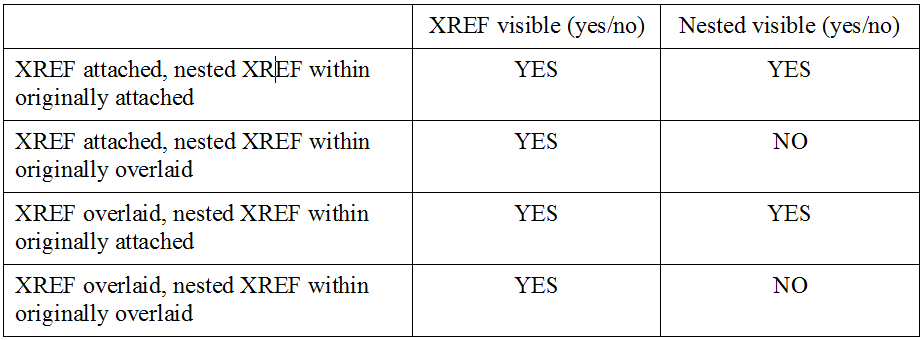
This dialog box opens when:
•you use File > External Content > Attach XREF
•you click “Attach” from the XREF Management dialog box. (File > External Content > XREF manager.)
XREF Name
Specify the name of the file to be attached as an external reference.
•Use the Browse button to select from a file selection dialog box.
•Alternatively, select from the pop-up list of already attached files if you want to place another instance of the file into the Project.
Path
Shows the exact path to the selected file.
Reference Type
Choose a radio button to set how nested XREFs will be handled.
Note: Nesting occurs when you load an external reference to a file that has external references loaded to other files.
Attachment
All levels of nesting can be displayed in the Project file.
Overlay
Nested XREFs from the referenced file will not be visible in the Project.
The following table shows what happens when you attach/overlay DWG files that contain attached/overlaid XREFs.

Examples:
1.A DWG file named BASE.DWG that has an attached XREF named COMMON.DWG is attached to the ARCHICAD Project. Both files will be visible on the Floor Plan.
2.A DWG file named BASE.DWG that has an overlaid XREF named COMMON.DWG is attached to the ARCHICAD Project. BASE.DWG will be visible on the Floor Plan but COMMON.DWG will not be visible.
3.A DWG file named BASE.DWG that has an attached XREF named COMMON.DWG is overlaid to the ARCHICAD Project. Both files will be visible on the Floor Plan.
4.A DWG file named BASE.DWG that has an overlaid XREF named COMMON.DWG is overlaid to the ARCHICAD Project. BASE.DWG will be visible on the Floor Plan but COMMON.DWG will not be visible.
Align Xref Origin and Rotate to Survey Point
Check this box to
•Place the Xref (using its own Drawing origin) at the ARCHICAD Survey Point
•Rotate it to match the Survey Point orientation.
If you check this box, the Insertion Point, Rotation and Anchor Point fields below are grey.
See also Survey Point.
Insertion Point
Specify the location of the xref in the project:
•Enter the exact coordinates, or
•Check Specify On-Screen to locate the xref when placing it.
Scale
Either specify a scale factor in both X and Y directions, or check the Specify On-Screen box to define scale on the screen.
Note: If you specify scale factors, the XREF’s enclosing box will be scaled to the appropriate size. If not, you will be able to stretch the enclosing rectangle just as if you were stretching an ARCHICAD object. It is possible to input or specify negative or positive values for scale factors. By specifying negative values you can achieve mirroring effects.
Rotation
You can define an angle by which the whole placed XREF will be rotated around its insertion point, or check the Specify On-Screen box to define rotation manually, on the screen.
Note: If you specify a rotation angle, the XREF is rotated and then drawn. If not, you can rotate the enclosing rectangle until you input the value with a mouse click or coordinate input.
Anchor Point
Choose an option to define the point used to select/drag the Xref .
•Drawing’s own origin: the Global Origin (0;0 coordinate) of the attached XREF.
•Drawing’s own anchor point: the attached XREF drawing’s own anchor point (if any)
•Bounding box node: ARCHICAD calculates the size of the bounding box of the attached XREF. You choose any of the 9 significant points of the bounding box.
Place on Story
Use this drop-down list to choose the story onto which to place the XREF. Before the actual placement, ARCHICAD will switch to that story.
Translator
This field displays the currently selected DXF/DWG Translator to be used during the conversion of the attached AutoCAD drawing. You may select any of the currently available Translators from the drop-down list. Clicking the Settings button will bring up the Translator Dialog where you can make modifications to the Translator Settings before attaching the XREF file.
For more information, see DXF/DWG Translation Setup.
Description
This field shows a short explanation and note about the currently selected Translator so you can decide if it fits your needs.
Attach
Click to attach the Xref.
Note: When you attach an external reference file to an ARCHICAD Project, a layer will be created for it. The resulting layer names will have the following format:
‘XREF_NAME | LAYER_NAME’.
For example, the PEN_56 layer of a DWG file that was attached to the project with the XREF name 3D_STUFF will become the layer 3D_STUFF|PEN_56.